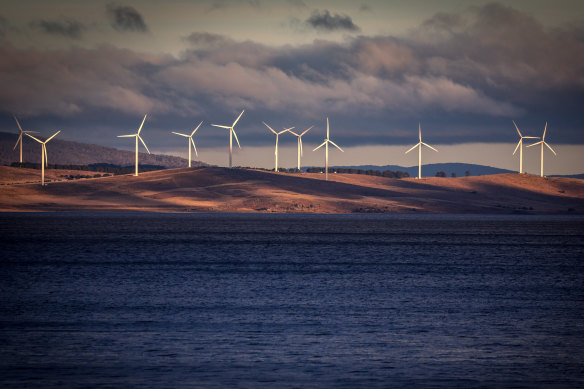This was published 9 months ago
Australia is building more renewables than ever. It’s still not enough
By Nick Toscano
Australia’s renewable energy transition has reached record speed this year, with more wind, solar and battery projects either being built or in their final stages of testing before delivering power to the grid than in any year.
While it is still only September, the rollout of renewable energy generation and storage assets across Australia during 2024 has already eclipsed the previous yearly record, new figures from global consultancy Rystad Energy reveal.
The start of construction at Spanish renewable energy giant Iberdrola’s Broadsound solar and battery farm in Queensland this month means Australia now has a combined 6.49 gigawatts of utility-scale solar, wind and batteries under construction.

Australia’s transition to renewable energy is running behind schedule.Credit: Getty
“This exceeds the previous record for a calendar year [6.47 gigawatts] with three months still remaining for 2024,” Rystad senior renewables analyst David Dixon said.
There have also been 4 gigawatts of projects “energised” – meaning they have started the required commissioning process to be able to dispatch power into the grid – in the past 12 months, toppling the previous record of 3.7 gigawatts in a year.
But the clean energy building blitz is still falling short of the pace required for Australia to remain within striking distance of the Albanese government’s targets to double the share of renewable energy in the grid from 40 per cent to 82 per cent by 2030.
The rollout of new renewable energy and storage projects and thousands of kilometres of new power lines needed to link them to major cities is also running behind the rate officials say is necessary to avoid worsening the threat of price spikes or blackouts, as the next wave of coal-fired power station shutdowns nears.
“There is a real risk that replacement generation, storage and transmission may not be available in time when coal plants retire,” Australian Energy Market Operator (AEMO) chief Daniel Westerman said earlier this year.
“This risk must be avoided,” he added.
While coal still accounts for the bulk of Australia’s electricity, at least half of the remaining coal-powered generators on the eastern seaboard are due to retire within the next decade, as the ageing and emissions-intensive equipment become less reliable and competitive against cheaper renewables.
AEMO, which oversees the interstate electrical grid, believes the number of impending coal plant closures could be even higher, with its latest modelling suggesting the fossil fuel is likely to have almost exited the grid entirely by 2035.
According to Rystad Energy, new utility solar and wind farm installations must exceed 6 gigawatts a year to meet the government’s 2030 climate ambitions.
“Despite records tumbling, Australia still needs to quicken the pace of utility solar and wind installations to exceed 6 gigawatts per year and keep on track for 2030 installation targets,” Dixon said.
Renewable energy developers said 2023 had been a “lean year” for investment in Australian wind farms, with not a single announcement of a wind project reaching financial close.
“Fortunately, this year is looking a bit better, with 1.5 gigawatts of capacity reaching final investment decisions in the first half of 2024,” Clean Energy Council chief executive Kane Thornton said.
“We should have big expectations for the second half of this year, but this won’t be easy – it requires great determination, grit and patience.”
The Business Briefing newsletter delivers major stories, exclusive coverage and expert opinion. Sign up to get it every weekday morning.